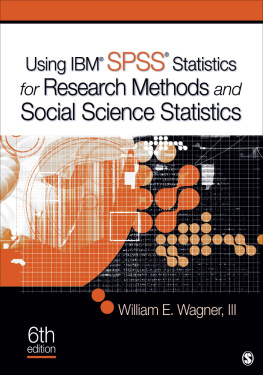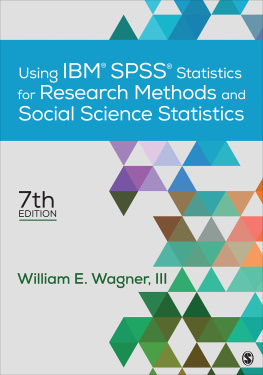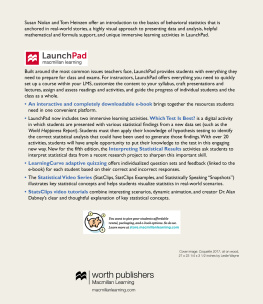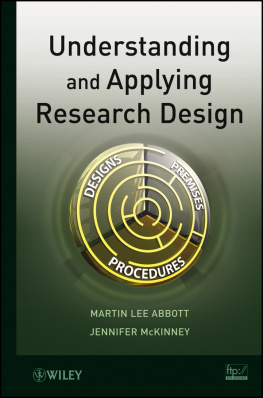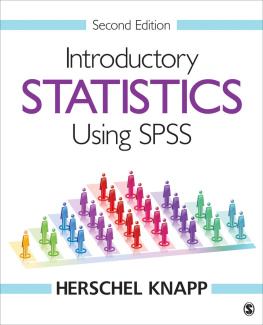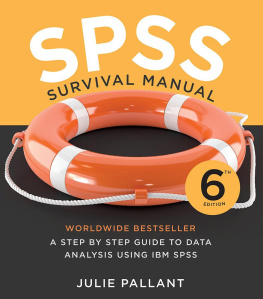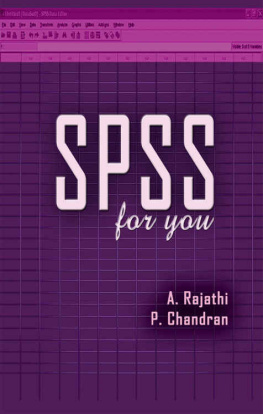John T. Kulas - IBM SPSS Essentials: Managing and Analyzing Social Sciences Data
Here you can read online John T. Kulas - IBM SPSS Essentials: Managing and Analyzing Social Sciences Data full text of the book (entire story) in english for free. Download pdf and epub, get meaning, cover and reviews about this ebook. year: 2021, publisher: Wiley, genre: Computer. Description of the work, (preface) as well as reviews are available. Best literature library LitArk.com created for fans of good reading and offers a wide selection of genres:
Romance novel
Science fiction
Adventure
Detective
Science
History
Home and family
Prose
Art
Politics
Computer
Non-fiction
Religion
Business
Children
Humor
Choose a favorite category and find really read worthwhile books. Enjoy immersion in the world of imagination, feel the emotions of the characters or learn something new for yourself, make an fascinating discovery.

- Book:IBM SPSS Essentials: Managing and Analyzing Social Sciences Data
- Author:
- Publisher:Wiley
- Genre:
- Year:2021
- Rating:4 / 5
- Favourites:Add to favourites
- Your mark:
- 80
- 1
- 2
- 3
- 4
- 5
IBM SPSS Essentials: Managing and Analyzing Social Sciences Data: summary, description and annotation
We offer to read an annotation, description, summary or preface (depends on what the author of the book "IBM SPSS Essentials: Managing and Analyzing Social Sciences Data" wrote himself). If you haven't found the necessary information about the book — write in the comments, we will try to find it.
John T. Kulas: author's other books
Who wrote IBM SPSS Essentials: Managing and Analyzing Social Sciences Data? Find out the surname, the name of the author of the book and a list of all author's works by series.
IBM SPSS Essentials: Managing and Analyzing Social Sciences Data — read online for free the complete book (whole text) full work
Below is the text of the book, divided by pages. System saving the place of the last page read, allows you to conveniently read the book "IBM SPSS Essentials: Managing and Analyzing Social Sciences Data" online for free, without having to search again every time where you left off. Put a bookmark, and you can go to the page where you finished reading at any time.
Font size:
Interval:
Bookmark:
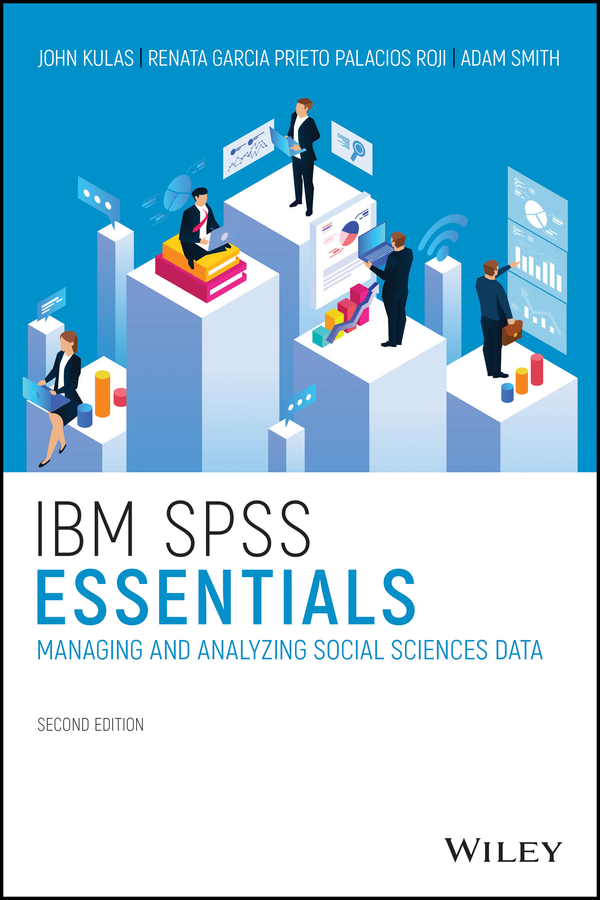
- Chapter 4
- Chapter 7
- Chapter 9
- Chapter 12
- Chapter 2
- Chapter 3
- Chapter 4
- Chapter 5
- Chapter 6
- Chapter 7
- Chapter 8
- Chapter 9
- Chapter 10
- Chapter 11
- Chapter 12
- Chapter 13
- Chapter 14
- Chapter 15
- Chapter 16
- Chapter 17
Second Edition
John Kulas
Northern Illinois University
Renata Garcia Prieto Palacios Roji
Montclair State University
Adam Smith
Auburn University

This edition first published 2021
2021 John Wiley and Sons, Inc.
Edition History
Jossey-Bass (1e, 2018)
All rights reserved. No part of this publication may be reproduced, stored in a retrieval system, or transmitted, in any form or by any means, electronic, mechanical, photocopying, recording or otherwise, except as permitted by law. Advice on how to obtain permission to reuse material from this title is available at http://www.wiley.com/go/permissions.
The right of John Kulas, Renata Garcia Prieto Palacios Roji, and Adam Smith to be identified as the authors of this work has been asserted in accordance with law.
Registered Office
John Wiley & Sons, Inc., 111 River Street, Hoboken, NJ 07030, USA
Editorial Office
111 River Street, Hoboken, NJ 07030, USA
For details of our global editorial offices, customer services, and more information about Wiley products visit us at www.wiley.com.
Wiley also publishes its books in a variety of electronic formats and by printondemand. Some content that appears in standard print versions of this book may not be available in other formats.
Limit of Liability/Disclaimer of Warranty
While the publisher and authors have used their best efforts in preparing this work, they make no representations or warranties with respect to the accuracy or completeness of the contents of this work and specifically disclaim all warranties, including without limitation any implied warranties of merchantability or fitness for a particular purpose. No warranty may be created or extended by sales representatives, written sales materials or promotional statements for this work. The fact that an organization, website, or product is referred to in this work as a citation and/or potential source of further information does not mean that the publisher and authors endorse the information or services the organization, website, or product may provide or recommendations it may make. This work is sold with the understanding that the publisher is not engaged in rendering professional services. The advice and strategies contained herein may not be suitable for your situation. You should consult with a specialist where appropriate. Further, readers should be aware that websites listed in this work may have changed or disappeared between when this work was written and when it is read. Neither the publisher nor authors shall be liable for any loss of profit or any other commercial damages, including but not limited to special, incidental, consequential, or other damages.
Library of Congress CataloginginPublication Data
Names: Kulas, John T., author.
Title: IBM SPSS essentials : managing and analyzing social sciences data /
John Kulas, Northern Illinois University, Renata Garcia Prieto Palacios Roji, Montclair State University,
Adam Smith, Auburn University.
Other titles: SPSS essentials
Description: Third edition. | Hoboken, NJ : John Wiley & Sons, Inc., [2020]
| Earlier editions published as: SPSS essentials : managing and
analyzing social sciences data.
Identifiers: LCCN 2020025372 (print) | LCCN 2020025373 (ebook) | ISBN
9781119417422 (paperback) | ISBN 9781119417439 (adobe pdf) | ISBN
9781119417446 (epub)
Subjects: LCSH: SPSS (Computer file) | Social sciences Computer programs.
Classification: LCC HA32 .K85 2020 (print) | LCC HA32 (ebook) | DDC
300.285/555 dc23
LC record available at https://lccn.loc.gov/2020025372
LC ebook record available at https://lccn.loc.gov/2020025373
Cover Design: Wiley
Cover Image: sesame/Getty Images
We would like to dedicate this book to those who have brought happiness, love, and fun into our lives Judy Kulas, Zak Kulas, Yvan Vazquez, Ricardo Garcia Prieto, Connie Palacios Roji, Steven Boomhower, and Lee & Phyllis Smith.
This book represents a summarized compilation of problemsolving successes that we collectively gleaned while working for various academic and private organizations. These are all institutions at which we've held jobs and at which at least a portion of our duties included minimizing errors in various applications (including SPSS).
This is a how to book. We present a system for using a software program known by the ubiquitous anagram: SPSS. You are not expected to know anything about SPSS at the beginning of the book however, by the time you get to the end of the book, you are expected to know enough about SPSS to comfortably use the program. The intended audience of this second edition is undergraduate students who are learning SPSS in classroom environments (whether the delivery of the class content is in person or online). This differs in focus from the first edition, which was intended to be a bookshelf reference a guide for practitioners who are using SPSS with realworld data (which is almost always messy). The information found in this book should not become outdated with future versions of SPSS the basic premise will be useful with SPSS version .
Regardless of slight shifting of organization and emphasis, the purpose of both versions of this book is to teach you how you should use SPSS. The goal throughout is to minimize errors. Errors can occur in data entry, analysis interpretation, and even the choice of which dataset to use for analysis. This last error, sadly, has increased in probability with the most recently released versions of SPSS. If you follow the how tos of this book, you will greatly decrease your likelihood of introducing errors into your research/analyses. Essentially, the book is a template for how you should organize your SPSS life. Generally speaking, you will learn to organize through keeping diaries of what you: (1) plan to do, (2) actually do, and (3) (perhaps regrettably) did.
The initial title of this book, when it was only used in the first author's personal statistics classes, was Use syntax or I'll bonk you over the head with this book and other cheerful stories from an SPSS practitioner. When it was decided that the material in that book should be made more widely available, the title was changed but the basic message of the initial book is the same our intent is to build your skill not only using SPSS, but also in using it in a manner that keeps a record of what you've done and increases your chances of finding and correcting errors. This is accomplished via using syntax.
Students will find this text helpful as a supportive framework while learning statistics knowing how to properly use SPSS will ideally parallel your increasing knowledge of statistical procedures (e.g. SPSS can confirm or disconfirm, for example, exercises that may also be calculated by hand). Instructors should find this text a useful stepoff point for instruction (i.e. you should be able to focus on SPSS's relevance to classroom material instead of database setup, variable identification, etc.). Practitioners will likely find the previous edition of this text a more useful reference and guide with realworld data, so we recommend searching for a first edition if you intend to use SPSS in your work (e.g. outside of a classroom setting).
Next pageFont size:
Interval:
Bookmark:
Similar books «IBM SPSS Essentials: Managing and Analyzing Social Sciences Data»
Look at similar books to IBM SPSS Essentials: Managing and Analyzing Social Sciences Data. We have selected literature similar in name and meaning in the hope of providing readers with more options to find new, interesting, not yet read works.
Discussion, reviews of the book IBM SPSS Essentials: Managing and Analyzing Social Sciences Data and just readers' own opinions. Leave your comments, write what you think about the work, its meaning or the main characters. Specify what exactly you liked and what you didn't like, and why you think so.

